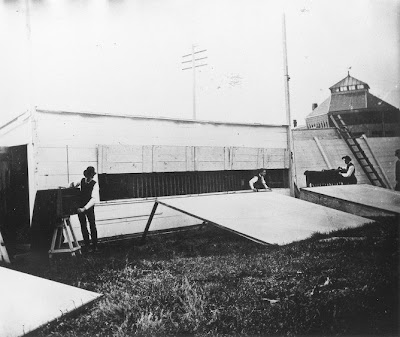by Gregg Chadwick
 |
Eadweard Muybridge
Muybridge Animal Locomotion, plate 288
circa 1887
|
"....'See how curiously,' said Mr. Muybridge, referring to a photographic series (Plate 288 shown above) of one of our most prominent University baseball nine, 'and yet how perfectly, this plate illustrates the occurrence of an error in catching.' True enough. In the successive pictures the ball is muffed, strikes the player's thigh, runs up under his arm and across his back, while he is looking eagerly on the wrong side for it."
- The Pennsylvanian, 1886
In the 19th century the railroad, the telegraph and the camera transformed our experience of space and time. JMW Turner's painting Rain, Steam, and Speed - The Great Western Railway documents in oil paint the beginnings of this perceptual shift. In Turner's work, the powerful steam engine races from the painting's perspectival vanishing point into the viewer's space, breaking free of pictorial constraints.
|
|
JMW Turner
Rain, Steam, and Speed - The Great Western Railway
36"x48" oil on canvas 1844
National Gallery, London
|
Eadweard Muybridge, born 182 years ago today, took Turner's artistic explorations and expanded upon them. Muybridge's photographic stop action photos revolutionized our understanding of human and animal movement.
Eadweard Muybridge
Muybridge Animal Locomotion, plate639
|
Not content with the long exposure times needed to create photographic plates, Muybridge's artistic explorations with instantaneous photography led to his groundbreaking motion studies. In the 1870s, at the Palo Alto Stock Farm owned by railroad baron and former California Governor Leland Stanford, Eadweard Muybridge invented his photographic method for the capture of high-speed action. Muybridge devised a system for documenting animal locomotion by using a series of cameras which produced sequential images of stilled movement on glass photographic plates. These photographs were arguably the first successful photographs of rapid motion and they revolutionized photography and the natural sciences.
 |
Photograph of one of the three batteries of cameras, with plateholder,
used by Muybridge to produce the Animal Locomotion images
circa 1887
© University of Pennsylvania | uarc@pobox.upenn.edu
|
These sequential images seemed to cut time into slices. The images recorded fractions of a second, which the unaided human eye had not been able to perceive before. Soon Muybridge would set his photographs into motion with his early motion picture device the Zoopraxiscope
and hand drawn silhouettes of his horse in motion photos seemed to gallop fluidly when viewed through the machine.
|
|
Muybridge’s Zoopraxiscope on display at the Kingston Museum
Kingston upon Thames, UK
|
Muybridge's Zoopraxiscope inspired Thomas Edison and William Kennedy Dickson's Kinetoscope, which in time led to the modern film projector.
After his photographic success in California, Eadweard Muybridge moved east and continued his studies with the assistance of the University of Pennsylvania in the 1880's.
|
|
Eadweard Muybridge's outdoor camera house, 36th and Pine Streets, Philadelphia
Members of the commission overseeing Muybridge's work at Penn included Thomas Eakins as well as professors from Penn's Medical, Veterinary and Engineering Schools. Student-athlete's and faculty members at Penn posed for Muybridge's motion studies.
|
 |
Thomas Eakins
A May Morning in the Park (The Fairman Rogers Four-in-Hand)
23 3/4" x 36" oil on canvas 1879-1880
Collection Philadelphia Museum of Art |
The artist Thomas Eakins, inspired by his interactions with Muybridge in Philadelphia, painted A May Morning in the Park (The Fairman Rogers Four-in-Hand). Eakin's depiction of a horse and carriage in stop-action motion was unprecedented in painting and seemed off putting to many contemporary viewers. One critic of the time wrote, "The effect of the picture as a whole it is impossible to accept as true, unless it be that Mr. Eakins' perceptions are right and those of everybody else are wrong." Eakin's dismissed the criticism and continued his explorations of motion in his photographic and painted works.
Muybridge's groundbreaking work continues to influence artists across the globe. The Japanese filmmaker Koji Yammamura's animated work Muybridge's Strings is a poetic homage to Muybridge and a poignant contemplation of time and memory: "Though separated by a century and an ocean, the lives of photographer Eadweard Muybridge and that of a Japanese mother clash poetically, sharing the irrepressible human desire to make time stand still."
Trailer for the animated film Muybridge's Strings by the Japanese filmmaker Koji Yamamura.
2011 /12 min. 39sec./ 35 mm /No dialogue /Canada, Japan
Techniques: Drawing and painting on paper
A CO-PRODUCTION OF THE NATIONAL FILM BOARD OF CANADA, NHK AND POLYGON PICTURES
Direction, Script, Editing Koji Yamamura
Original Music, Sound Design Normand Roger, Pierre Yves Drapeau, Denis Chartrand
Executive Producers David Verrall (NFB), Kenji Saito (NHK), Shuzo John Shiota (Polygon)
Producers Michael Fukushima (NFB), Keisuke Tsuchihashi (NHK), Shuzo John Shiota (Polygon)
 |
Gregg Chadwick
I Canti (The Cantos)
78"x60" oil on linen 2011 |
My own work I Canti (The Cantos) can be seen as a rumination on time and memory inspired by Muybridge's discoveries.
Also in the Los Angeles area, Mark Arnon Rosen and Wendy Marvel's mechanical flip books evoke a world caught between Muybridge and the 21st century:
And today Google got into the act with a witty Google Doodle honoring Muybridge:
More at:
Yamamura Animation
Eadweard Muybridge Doodle
X-Ray Dreams


















